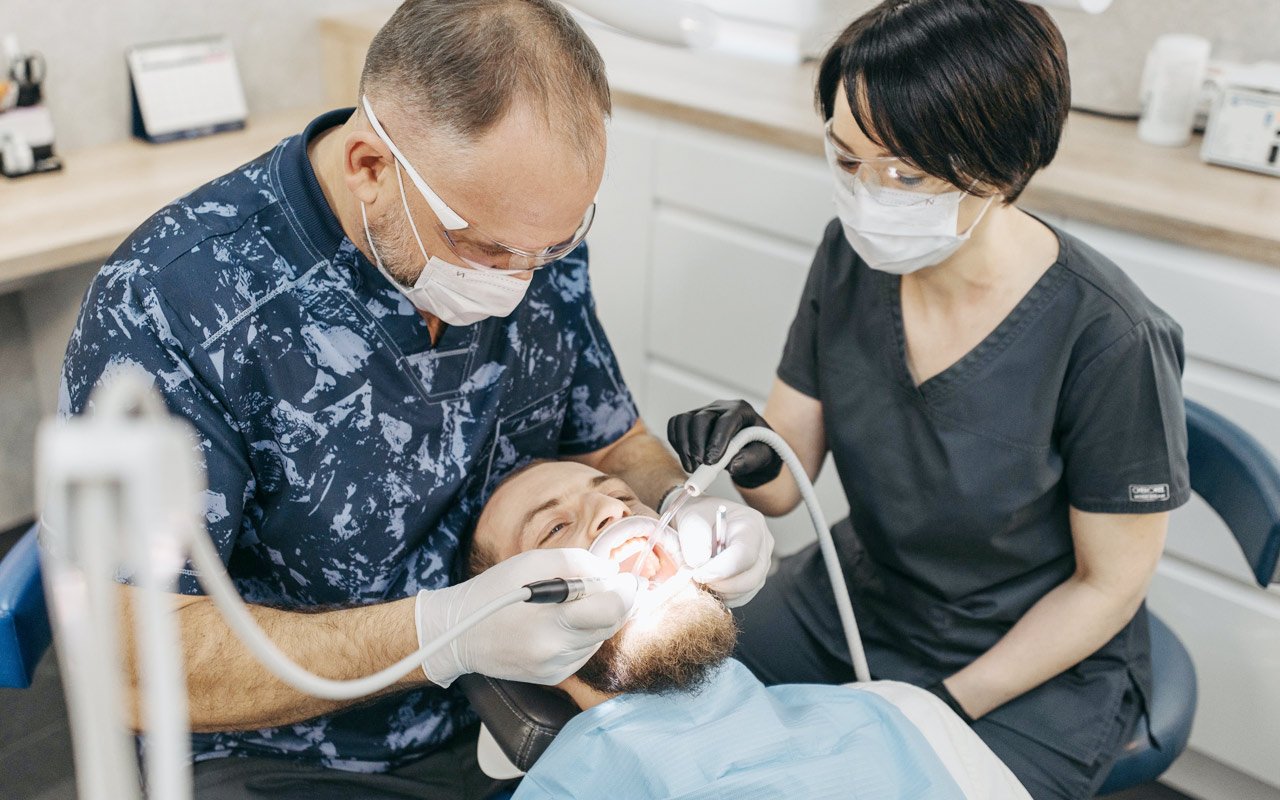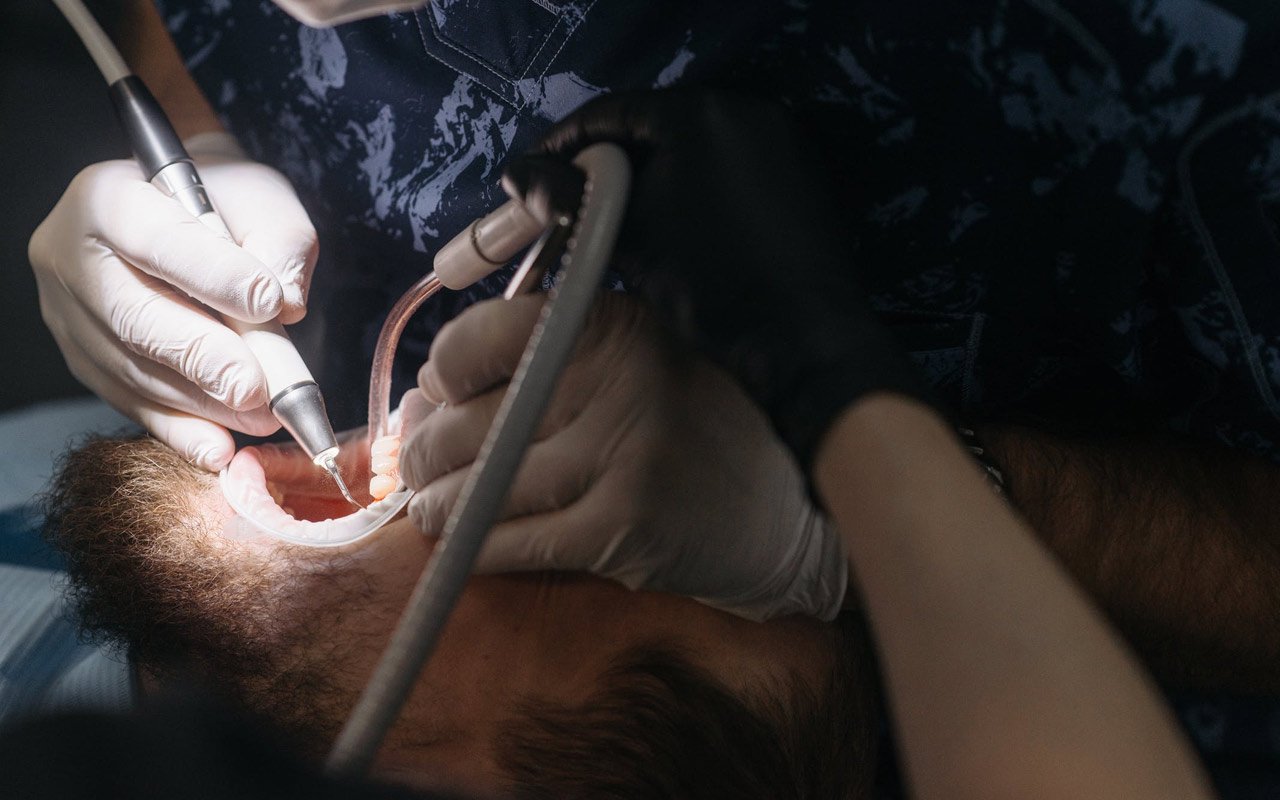Headache or temple pain after a tooth extraction is not uncommon. The use of injections and medications during the procedure can cause headaches and temple pain by putting pressure on the facial structure.
If there is no other way to save the tooth, a tooth extraction will be performed. It is difficult and can be dangerous. It is possible for the tissues, gums, and surrounding teeth to become infected, loosen, and eventually fall.
So it is important to act quickly before it becomes too late. Each day, many extractions are performed at the dental office. It is routine and the area heals in a few days. However, proper aftercare is necessary.
A headache or temple pain following a tooth extraction is not something that people often complain about. This article will explain the causes of headaches or temple pain and other symptoms that can occur after tooth extraction.
Table of Contents
Headache or temple pain after tooth extraction
Headaches or temple pain can be caused by many things, such as fatigue, tension, work, or diseases. It is common to experience headaches or temple pain after a tooth is extracted. The process of removing a portion of your body can be difficult.
With the right aftercare, most patients recover within a few days of tooth extraction. Not everyone who has a tooth extracted will have a headache. Some people have anxiety-related headaches after tooth extraction. In most cases, it will go away in a few days as soon as the area heals.
Studies show that it takes 1 to 2 weeks for the extraction site to heal completely. However, the pain of a tooth extraction typically fades in the 24 to 72 hours following the surgery.
In particular, there are some cases where a headache can be experienced up to 7 days after tooth extraction.
These cases are relatively rare and the cause may be alveolar osteomyelitis. In medicine, the clinical term for dry socket is alveolar osteomyelitis. Dry sockets usually last for about 7 days after tooth extraction.
Pain can be noticed as early as day 3 of this cycle. After tooth extraction, a blood clot often forms at the extraction site to heal and protect the extraction site.
The use of an anesthetic before the tooth extraction will help the patient feel no pain. However, the extraction process will put pressure on the facial structure, affecting the muscles in the face, and causing headaches or pain in the temples.
This pain does not appear during the procedure when the dentist performs the extraction for you thanks to the analgesic effect of the anesthetic. However, once the sedative effect wears off, the patient will begin to feel pain at the extraction site.
The level of pain will depend on the type of tooth being extracted. Usually, the pain goes away completely after up to 3 days.
If you still have a headache or temples after 5 days or more of tooth extraction, you need to see your doctor right away.
At this point, the headache may not be due to tooth extraction because there are many other causes of headaches or pain in the temples. It is also possible that the headache is caused by other reasons, such as an underlying infection, dry sockets, decayed bones, or damage to the sinuses.
During a tooth extraction, the jaw and mouth muscles contract. This can cause headaches by affecting the head and face muscles. Because of the strain on your facial muscles, you may experience headaches or temple pain after a tooth is extracted.
The strain begins at the gums and continues to your head. Jaw pain can also be felt. If you have fear of tooth removal or dental treatment, jaw pain and headaches are more common.
Fear of losing teeth can cause tension in your mouth and muscles. This causes headaches and pain that are more severe.
We recommend that you visit a dentist if you have fear of having your tooth extracted. You don’t need to be anxious while visiting the dentist’s office.
Headaches after dental work are not only a result of fear. They can also be caused by stress, fatigue, illnesses, or workload. It’s not unusual to have a headache after having a tooth removed.
Your facial structure is subject to pressure, which eventually causes headaches. The sedatives you are given won’t cause any pain, but it will be difficult to feel the discomfort.
After the sedative effects wear off, sinus pain and headaches can occur. Other reasons for pain and headaches following the removal of teeth include an underlying infection, dry socket, bone decay, or sinus damage.
Reasons for having a headache after tooth extraction
Ever wonder why you feel headaches or throbbing pain after having your tooth removed?
If your natural tooth cannot be saved, you may have to have it extracted. It’s not an easy task but it will make your oral condition worse.
In other words, if your dentist does not perform tooth removal, then your gums, surrounding teeth, and other teeth could become infected, or even fall out.
It’s best to act sooner rather than later. Tooth extraction is not a complicated procedure. Each day, dentists remove many teeth.
Most patients can recover in a matter of days if they receive proper aftercare. Some people have headaches after a tooth is extracted.
It will subside after a few days, once the area has healed. This sensation is common but not essential.
Is it common to have migraines after a tooth is removed? Let’s find out what can cause headaches after teeth or molars are extracted.
Tooth infections that can cause headache
It is necessary to extract a tooth if it has pus from an infection that causes a lot of pain. In such cases, you may experience fever, swelling, bleeding, headaches, and even headaches.
An extraction is performed to remove a decayed tooth, as well as pus so that the infection doesn’t spread to the gums. To make the procedure less painful and more comfortable, few medicines are administered.
However, good aftercare is important. Even so, even the smallest traces of infection can cause headaches.
Is it painful to have a dry socket?
An empty socket will form in the jaw and gum. A cloth will cover it. It will heal in a few weeks. A dry socket can form due to an error. This can be very painful. Dry sockets are caused by the loss of the cloth from the area.
This can happen due to drinking carbonated beverages, using a straw smoking, as well as accidentally biting the socket. The loss of the cloth can expose nerves which can lead to severe pain.
Therefore, it is important that the patient see a dentist right away.
Rare possibilities
Although rare, cases of rupturing sinuses or decaying bones can happen and cause headaches.
Our sinuses are located on the top of our upper third molars. Any complications during extraction could cause it to burst, which can lead to headaches.
It is possible for a portion of the bone to die and not heal, which can cause the pain to remain in the gums for weeks. If the headache persists after a tooth is extracted, it’s better to call for a consultation.
Tooth Extraction Aftercare
It is important to take good care of your mouth after having a tooth extracted. You can heal quicker by taking proper care of your mouth and avoiding certain foods.
Control bleeding
To help control bleeding after tooth extraction, your dentist will give you gauze. You can exert pressure on the tooth socket by pressing down on the gauze.
This will allow blood clots to form. It’s a good idea not to chew on the tooth after extraction.
Tea contains tannic acid which helps form blood clots. This will allow your wounds to heal quickly and reduce bleeding.
Swelling and pain can be reduced
After the teeth removal, it is not uncommon to feel discomfort and swelling. To reduce the pain, you can use over-the-counter pain relievers.
Apply a cold and hot compress to the area of surgery. This will reduce swelling. Apply an ice pack to your cheeks for 10 minutes.
Next, take a 5-minute break and then go back to the same process. There will be some bruising around your eyes, which is normal.
After a few days, the swelling should disappear.
Diet after tooth extraction
It is important to understand what you should eat following tooth extraction in order to heal quickly and avoid any complications. Soft and liquid foods should be avoided. This will help you save some pain.
Here are some examples of soft food:
- Yogurt
- Smoothies
- Applesauce
- Mashed potatoes
- Blended soups
- Pudding
- Avocado
- Scrambled eggs
- Ice-cream
- Soft cheese
After the first few days, semi-soft foods can be added gradually. Start with toast and oatmeal, then move on to fruits and veggies. Before you make any changes to your diet, it is worth talking with your dentist.
Avoid these foods
Avoid eating sticky, hard foods. These foods can cause you to exert more pressure on your wound and may even injure it. Sticky foods can stick to the extraction site, causing pain.
Avoid hot liquids and foods. They can increase swelling. Avoid smoking and limit alcohol consumption for the first few days following surgery.
Avoiding these foods and other habits will make your journey to recovery easier.
Symptoms of an Infection After Tooth Extraction
Your body’s natural response is too minor swelling and discomfort. Some symptoms may indicate a more serious problem. If you notice any of these signs after a tooth extraction, contact your doctor immediately.
- Bleeding for more than 24 hours
- Pain that isn’t managed with pain medication
- Swelling of the jaw, face, and gums
- Pus discharge
- Discomfort when chewing or talking
- Increased or persistent fever
Remedies for Temple Pain and Headaches after tooth extraction
It can be very bothersome to suffer from temple pain that causes headaches. Here are some home remedies to help you if you have temple pain or headaches after tooth extraction.
Wash with warm salt water
A long-tested remedy for pain relief is warm water rinse. Research has shown that warm water mixed with sodium chloride (salt), can kill bacteria and promote healthy gums.
Keep your mouth clean to prevent infections that could lead to complications after tooth extraction. Warm salt water rinses with warm salt water will keep your mouth clean and bacteria-free.
This includes flossing at least once per day and brushing twice daily.
Use an aspirin
After tooth extractions, Aspirin can be used to treat headaches and temple pain. Aspirin is also effective in reducing pain sensation. Follow the directions on it. Only take what your doctor has directed.
Use a cold or hot compress
After teeth extraction, migraines can often be triggered by pain sensation. It is often caused by tension and persistent swelling.
A cold compress can reduce swelling and pain. Heat pads, on the other hand, can be used to relax tight muscles and increase blood flow around the area.
This can often ease headaches and temple pain following tooth extraction.
Frequently Asked Questions
When can you drink carbonated drinks after tooth extraction?
Drinking carbonated drinks should be avoided for at least four days following tooth extraction. Avoid using a straw, smoking cigarettes, or forcible drinking. These behaviors can lead to a dry socket that can be very painful.
If you have symptoms of dry socket, it is important to see an emergency dentist right away. We offer extended hours and can accommodate any last-minute appointment to help you with your emergency.
What are the signs of an infection after a tooth extraction?
Fever, swelling, redness, pain, and swelling are all signs of infection. These infections usually occur within a few days of a procedure and require time for them to develop. There are also late infections that can occur up to four weeks after extraction.
How do you know if a tooth infection has spread to your brain?
Symptoms of tooth infection spreading to the brain
- Fever.
- Headache.
- Chills.
- Visual changes
- One side of weakness in the body
- Seizures.
- Nausea.
- Vomiting.
Is it normal to have a headache a week after tooth extraction?
You may feel pain or discomfort after having a tooth removed, especially if it is molars.
Headache days after a tooth extraction is not typical. Mouth and jaw muscle tense up after tooth extraction. This can affect the facial muscles as well as the head muscles, causing headaches.
Tight facial muscles are the underlying cause of pain or headaches after tooth extraction. Tension starts at the gums and travels up to the head along the nerves.
However, this only happens a few days after tooth extraction. You can get quick relief with ice or heat and perhaps an anti-inflammatory pain reliever. If the headache still occurs 5 to 7 days after tooth extraction, you need to contact your doctor or go to the nearest medical facility to be checked.
How do you get rid of a headache after a tooth extraction?
Warm salt water rinses with warm salt water will keep your mouth clean and bacteria-free. Brushing twice daily and flossing once per day are two of the best ways to keep your mouth clean. After tooth extraction, aspirin can be used to treat headaches.
Why does my temple hurt after tooth extraction?
A dry socket refers to a blood clot that has been removed prematurely from the socket. Three to five days after your surgery, you may feel pain near the site of the procedure and/or radiating pain to the ears or temples. If you experience any of these symptoms, please call our office.
Can dental problems cause temple pain?
TMJ disorders can also lead to headaches. These headaches are described as an aching pain that starts near the ear and moves towards the jaw, neck, or temple. These headaches can be caused by jaw movements like chewing or opening the mouth.
Why does my head hurt after tooth extraction?
The jaw and mouth muscles contract during tooth extractions, which can affect the face. Headaches can be caused by tightening muscles. The tension in facial muscles that spreads from the gums to the head causes headaches after tooth extraction.
How long do headaches last after tooth extraction?
Your dental extraction may have caused headaches, sore throats, or pain around your temples, jaw, and neck. These symptoms should disappear within 1-3 days.
Can I have headaches 2 weeks after wisdom teeth removal?
Wisdom teeth are the last four permanent teeth to erupt in adulthood, located at the innermost corners of the upper and lower jaws.
After wisdom tooth removal, you may temporarily experience some conditions such as headache, pain in the temples, pain in the jaw muscles, or pain at the site of wisdom tooth extraction. This is the result of surgery.
Your other teeth may also be sore. This is called glans pain and is also a temporary condition.
You may experience discomfort or pain for 3-7 days after wisdom tooth extraction. However, if you have a headache or pain at the site of the tooth extraction 2 weeks after wisdom tooth extraction, you should see your doctor right away.
One of the most common causes of wisdom tooth extraction headaches is the heavy invasion of smooth tissue. This condition stems from a problem: The doctor performs too many osteotomies.
Severe soft tissue invasion causes many problems. Especially the daily routine. This situation is something no one wants to encounter but does not know how to prevent. The best way to avoid this situation is to find a reputable dentist.
Can I have a headache 2 days after tooth extraction?
You may also experience some bleeding at the extraction site. However, the bleeding will stop after about 2 hours of extraction.
Along with that, you may also experience headaches or pain in your temples. Headaches after tooth extraction are the most common for most people but go away once the area heals.
Not everyone gets a headache after tooth extraction, and if it does, the severity of the pain can vary. The headache can occur within 2 days of tooth extraction, and it should go away once the extraction site is completely healed.
Since these two days are so important to your extraction, we recommend: Getting plenty of rest and taking good care of your oral hygiene. Rest for at least the first 24 hours after tooth extraction.
Is it normal to have headaches months after tooth extraction?
As mentioned above, in most cases, the pain will go away after a few days of tooth extraction. If you are still experiencing headaches for months after tooth extraction, you need to see a doctor right away because this headache could be caused by another cause such as an underlying infection, sinus damage, decaying bone, or dry socket.
- References:
What to know about tooth extraction https://www.medicalnewstoday.com/articles/327170
TMJ Headache: Symptoms, Treatment, Causes, and One Side https://www.healthline.com/health/tmj-headache#causes
Causes of Tooth Pain and Treatment Options https://www.verywellhealth.com/why-does-my-tooth-hurt-1059322



